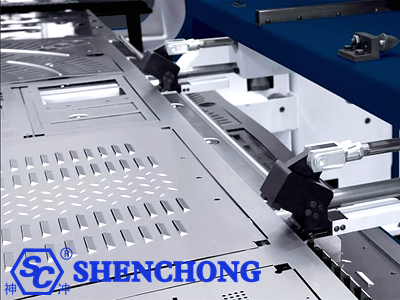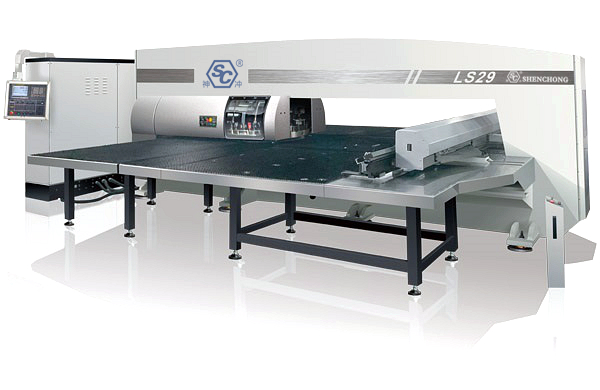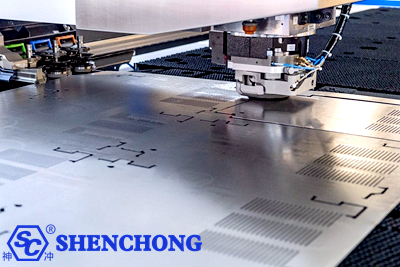
The sheet metal punching noise problem is a common phenomenon in industrial production. How to reduce the noise of punch presses? Why does CNC punching machine make noise?

CNC sheet metal punching noise problems during machine operation is a common phenomenon in industrial production. Excessive noise will affect the comfort of the operating environment and even endanger the health of workers.
Therefore, it is very important to analyze and solve the reasons for the high noise. The following are common reasons for the high noise of CNC punch presses and their analysis:
Improper mold gap: Too small mold gap will increase the punching force and increase the impact noise of the punch press. Too large gap will cause deformation or vibration of the sheet and generate more noise.
Insufficient mold precision: Imprecise mold manufacturing leads to vibration or impact noise during punching.
Mold wear: After long-term use, the mold edge becomes blunt or damaged, which will increase the punching force and generate more vibration noise.
The gap between the slider and the guide rail is too large: The slider of the punch press shakes during operation, increasing the mechanical impact noise.
Wear of transmission system: Wear or insufficient lubrication of transmission parts such as gears, bearings or connecting rods will cause increased noise during mechanical operation.
Insufficient rigidity of punch body structure: Insufficient strength of the equipment body leads to amplified vibration, which in turn generates loud noise.
When the CNC punch runs at too high a speed, the punching frequency increases, and the impact and vibration generated at the moment of punching will aggravate the noise.
When the punch returns after punching, the buffering mechanism does not work properly or is missing, resulting in increased impact noise.
When the thickness of the processing material is large or the hardness is high, the force required for punching increases, and the impact noise is more obvious.
Special materials (such as high-strength steel, composite materials) will produce sharp noises during punching.
The workpiece is not firmly fixed during the punching process, which will generate additional noise due to vibration or swing.
If the walls or ceilings of the workshop are made of hard materials, it is easy to reflect the noise of the punching machine at work, forming a superposition effect, making the noise appear louder.
Workshops with small spaces or dense equipment are more likely to amplify noise.
- Ground vibration transmission
The vibration generated by the operation of the punching machine is transmitted through the ground, which will aggravate the noise transmission.
The mechanical parts of the punching machine, such as slide rails and bearings, are not lubricated enough, which increases the friction noise during operation.
After the equipment has been running for a long time, key parts such as bolts and guide rails may loosen, causing vibration and impact noise.
If the equipment is not calibrated regularly, key components may shift, resulting in abnormal noise during movement.
Workers do not correctly select processing parameters (such as pressure, speed, mold gap, etc.) during operation, resulting in abnormal operation of the equipment and increased noise.
Long-term high-load processing may cause fatigue operation of the equipment and generate unnecessary noise.
Check whether the mold gap is appropriate, and sharpen the cutting edge or replace the damaged mold in time.
Improve the manufacturing accuracy of the mold and reduce the vibration and impact generated during the punching process.
Regularly check the guide rails, slides and transmission systems of the punch press to ensure adequate lubrication and eliminate the problem of loose parts.
Replace or repair transmission parts such as gears and bearings to reduce mechanical noise.
Adjust parameters such as punching speed and pressure according to material characteristics to avoid excessive impact force.
For hard materials or thick plate materials, punching can be performed in steps to reduce the punching force.
Install sound-absorbing materials on the walls or ceilings of the workshop to reduce noise reflection.
Install anti-vibration pads or basic vibration reduction devices under the punch press to reduce vibration conduction.
Reasonably arrange equipment spacing to avoid noise resonance.
Set up sound insulation barriers or soundproof rooms to reduce noise leakage.
Regularly train operators to ensure that processing parameters are set correctly.
Develop a daily inspection and maintenance plan for equipment to promptly detect and solve noise problems.
The reason why CNC punching machines are noisy is usually related to molds, equipment mechanical structures, materials, operating environment, and maintenance. By optimizing equipment design, maintenance systems, and workshop environment, and using punch presses correctly, working noise can be effectively reduced, creating a more comfortable and safe working environment for workers, while improving processing efficiency and product quality.

Reducing sheet metal punching noise is an important measure to improve the quality of the production environment and protect the health of operators.
It can be started from the equipment itself, processing technology, workshop environment and management and maintenance. The following is a detailed solution:
Use a silent punching machine: Choose a silent punching machine with a noise damping structure to reduce the noise during mechanical operation and impact.
Strengthen the rigidity of the equipment: Improve the rigidity of the punching machine body and reduce the noise caused by vibration transmission.
Improve the slider guide system: Use high-precision low-noise guide rails to reduce the noise of slider movement.
Reasonable gap design: Ensure that the mold gap is appropriate to avoid excessive impact force due to too small gap, or vibration caused by too large gap.
Improve mold accuracy: Use high-precision molds to reduce irregular vibration during punching.
Regularly grind the mold: Keep the mold edge sharp and reduce the stretching noise of the material during punching.
Add a buffer mechanism during the return of the punch to avoid the impact noise during the return of the punch.
Install flexible buffer devices for the punching process to reduce the impact of the punching force on the machine tool.
Regularly lubricate the transmission parts and guide rails to reduce the noise caused by friction.
Use high-performance, durable lubricants to ensure long-lasting lubrication effects.
Appropriately reduce the punching speed, reduce the impact frequency and instantaneous release of force, and reduce noise.
Where possible, punch in steps or use a slow feed process.
Adjust the processing pressure and punching speed according to the thickness and hardness of the material to avoid excessive force causing noise.
Replace some traditional metal punching processes with laser cutting or water cutting, which have lower noise and high processing accuracy.
During the processing, fix the workpiece firmly to avoid vibration and swing causing additional noise.
Use clamping devices or special fixtures to improve processing stability.
Sound-absorbing materials: Install sound-absorbing materials such as sound-absorbing panels, sound-proof cotton, etc. on the walls, ceilings or equipment of the workshop.
Noise barrier: Equip the metal punching machine with a soundproof cover or soundproof screen to prevent noise from spreading outward.
Soundproof room: Isolate the punch press with loud noise in a separate soundproof room.
Shock-absorbing pads: Install shock-absorbing pads on the base of the punch press to reduce the noise caused by equipment vibration during punching.
Base shock absorption: Install the punch press on a shock-absorbing foundation to block the spread of ground vibration.
Arrange equipment reasonably and place equipment with higher noise away from the operating area or crowded areas.
Maintain the distance between equipment in the workshop to avoid resonance between equipment to amplify noise.
Regularly check the wearable parts such as sliders, guide rails, bearings, etc., and replace or repair them in time to avoid additional noise caused by aging of parts.
Tighten the bolts, connectors, etc. of the equipment to prevent looseness and vibration noise.
Develop an equipment lubrication plan to ensure that all moving parts are always in good lubrication condition.
Use high-quality lubricating oil to reduce mechanical friction noise.
Regularly repair or replace passivated molds to keep the mold edges sharp and reduce material stretching and vibration noise during punching.
Train workers to correctly set up and operate equipment to avoid noise caused by equipment overload or improper processing due to misoperation.
Emphasize the standardized method of clamping workpieces to avoid additional noise caused by unfixed workpieces.
Equipped with noise monitoring equipment, real-time monitoring of workshop noise levels, and timely measures to deal with abnormal noise.
Regularly evaluate the noise sources in the workshop and optimize equipment or processes in a targeted manner.
If the noise cannot be completely eliminated in the short term, provide workers with protective equipment such as earmuffs or earplugs to reduce the direct harm of noise to the human body.
Choose equipment with silent technology or add silent components to existing equipment.
Use robots and automated systems to replace manual operations to reduce the impact on workers' health, while optimizing processing parameters to reduce noise.
Introduce intelligent CNC systems to automatically adjust punching parameters according to different materials and processing tasks to reduce noise.

To reduce the metal punching noise, it is necessary to comprehensively consider factors such as equipment, process, environment, maintenance and operation. By optimizing equipment design, improving processing technology, strengthening equipment maintenance and optimizing workshop environment, the noise of punching machines can be significantly reduced, thereby creating a safer, more comfortable and efficient production environment.
Other articles about metal punching:
Introduction Of CNC Turret Punch Press
Sheet Metal Punch Machine Operation Safety [How To Guide]
CNC Punching Machine Guide: Use, Featues And Classification
Classification Of Sheet Metal Punch Presses
Comprehensive Guide To Sheet Metal Punching Process